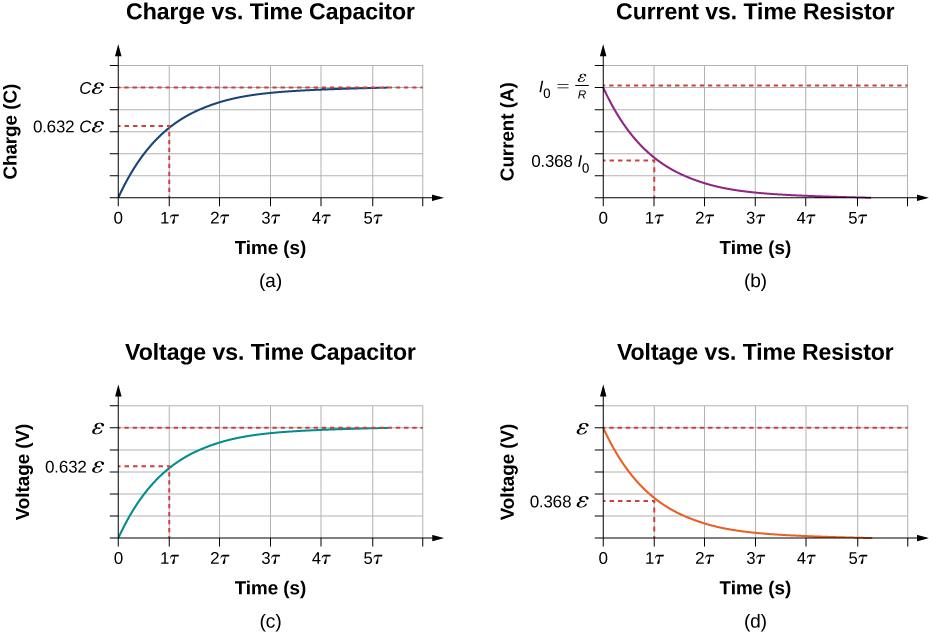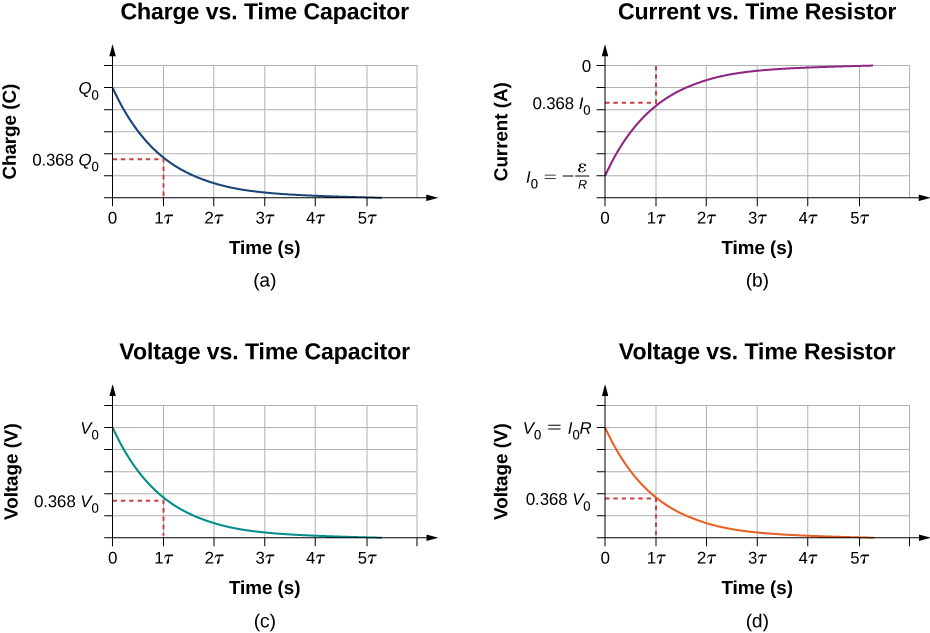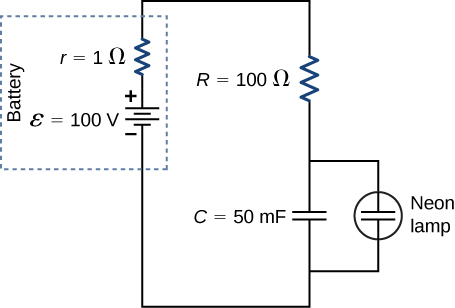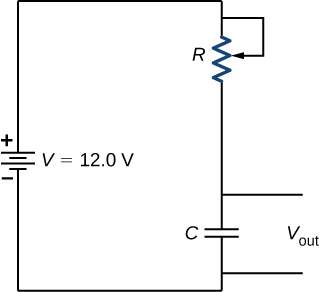10.5 RC Circuits
Learning Objectives
By the end of this section, you will be able to:
- Describe the charging process of a capacitor
- Describe the discharging process of a capacitor
- List some applications of RC circuits
When you use a flash camera, it takes a few seconds to charge the capacitor that powers the flash. The light flash discharges the capacitor in a tiny fraction of a second. Why does charging take longer than discharging? This question and several other phenomena that involve charging and discharging capacitors are discussed in this module.
Circuits with Resistance and Capacitance
An RC circuit is a circuit containing resistance and capacitance. As presented in Capacitance, the capacitor is an electrical component that stores electric charge, storing energy in an electric field.
Figure 10.38(a) shows a simple RC circuit that employs a dc (direct current) voltage source , a resistor R, a capacitor C, and a two-position switch. The circuit allows the capacitor to be charged or discharged, depending on the position of the switch. When the switch is moved to position A, the capacitor charges, resulting in the circuit in part (b). When the switch is moved to position B, the capacitor discharges through the resistor.

Charging a Capacitor
We can use Kirchhoff’s loop rule to understand the charging of the capacitor. This results in the equation This equation can be used to model the charge as a function of time as the capacitor charges. Capacitance is defined as so the voltage across the capacitor is . Using Ohm’s law, the potential drop across the resistor is , and the current is defined as
This differential equation can be integrated to find an equation for the charge on the capacitor as a function of time.
Let , then The result is
Simplifying results in an equation for the charge on the charging capacitor as a function of time:
A graph of the charge on the capacitor versus time is shown in Figure 10.39(a). First note that as time approaches infinity, the exponential goes to zero, so the charge approaches the maximum charge and has units of coulombs. The units of RC are seconds, units of time. This quantity is known as the time constant:
At time , the charge is equal to of the maximum charge . Notice that the time rate change of the charge is the slope at a point of the charge versus time plot. The slope of the graph is large at time and approaches zero as time increases.
As the charge on the capacitor increases, the current through the resistor decreases, as shown in Figure 10.39(b). The current through the resistor can be found by taking the time derivative of the charge.
At time the current through the resistor is . As time approaches infinity, the current approaches zero. At time , the current through the resistor is

Figure 10.39(c) and Figure 10.39(d) show the voltage differences across the capacitor and the resistor, respectively. As the charge on the capacitor increases, the current decreases, as does the voltage difference across the resistor The voltage difference across the capacitor increases as
Discharging a Capacitor
When the switch in Figure 10.38(a) is moved to position B, the circuit reduces to the circuit in part (c), and the charged capacitor is allowed to discharge through the resistor. A graph of the charge on the capacitor as a function of time is shown in Figure 10.40(a). Using Kirchhoff’s loop rule to analyze the circuit as the capacitor discharges results in the equation , which simplifies to . Using the definition of current and integrating the loop equation yields an equation for the charge on the capacitor as a function of time:
Here, Q is the initial charge on the capacitor and is the time constant of the circuit. As shown in the graph, the charge decreases exponentially from the initial charge, approaching zero as time approaches infinity.
The current as a function of time can be found by taking the time derivative of the charge:
The negative sign shows that the current flows in the opposite direction of the current found when the capacitor is charging. Figure 10.40(b) shows an example of a plot of charge versus time and current versus time. A plot of the voltage difference across the capacitor and the voltage difference across the resistor as a function of time are shown in parts (c) and (d) of the figure. Note that the magnitudes of the charge, current, and voltage all decrease exponentially, approaching zero as time increases.

Now we can explain why the flash camera mentioned at the beginning of this section takes so much longer to charge than discharge: The resistance while charging is significantly greater than while discharging. The internal resistance of the battery accounts for most of the resistance while charging. As the battery ages, the increasing internal resistance makes the charging process even slower.
Example 10.8
The Relaxation Oscillator
One application of an RC circuit is the relaxation oscillator, as shown below. The relaxation oscillator consists of a voltage source, a resistor, a capacitor, and a neon lamp. The neon lamp acts like an open circuit (infinite resistance) until the potential difference across the neon lamp reaches a specific voltage. At that voltage, the lamp acts like a short circuit (zero resistance), and the capacitor discharges through the neon lamp and produces light. In the relaxation oscillator shown, the voltage source charges the capacitor until the voltage across the capacitor is 80 V. When this happens, the neon in the lamp breaks down and allows the capacitor to discharge through the lamp, producing a bright flash. After the capacitor fully discharges through the neon lamp, it begins to charge again, and the process repeats. Assuming that the time it takes the capacitor to discharge is negligible, what is the time interval between flashes?
Strategy
The time period can be found from considering the equation whereSolution
The neon lamp flashes when the voltage across the capacitor reaches 80 V. The RC time constant is equal to We can solve the voltage equation for the time it takes the capacitor to reach 80 V:Significance
One application of the relaxation oscillator is for controlling indicator lights that flash at a frequency determined by the values for R and C. In this example, the neon lamp will flash every 8.13 seconds, a frequency of The relaxation oscillator has many other practical uses. It is often used in electronic circuits, where the neon lamp is replaced by a transistor or a device known as a tunnel diode. The description of the transistor and tunnel diode is beyond the scope of this chapter, but you can think of them as voltage controlled switches. They are normally open switches, but when the right voltage is applied, the switch closes and conducts. The “switch” can be used to turn on another circuit, turn on a light, or run a small motor. A relaxation oscillator can be used to make the turn signals of your car blink or your cell phone to vibrate.RC circuits have many applications. They can be used effectively as timers for applications such as intermittent windshield wipers, pace makers, and strobe lights. Some models of intermittent windshield wipers use a variable resistor to adjust the interval between sweeps of the wiper. Increasing the resistance increases the RC time constant, which increases the time between the operation of the wipers.
Another application is the pacemaker. The heart rate is normally controlled by electrical signals, which cause the muscles of the heart to contract and pump blood. When the heart rhythm is abnormal (the heartbeat is too high or too low), pace makers can be used to correct this abnormality. Pacemakers have sensors that detect body motion and breathing to increase the heart rate during physical activities, thus meeting the increased need for blood and oxygen, and an RC timing circuit can be used to control the time between voltage signals to the heart.
Looking ahead to the study of ac circuits (Alternating-Current Circuits), ac voltages vary as sine functions with specific frequencies. Periodic variations in voltage, or electric signals, are often recorded by scientists. These voltage signals could come from music recorded by a microphone or atmospheric data collected by radar. Occasionally, these signals can contain unwanted frequencies known as “noise.” RC filters can be used to filter out the unwanted frequencies.
In the study of electronics, a popular device known as a 555 timer provides timed voltage pulses. The time between pulses is controlled by an RC circuit. These are just a few of the countless applications of RC circuits.
Example 10.9
Intermittent Windshield Wipers
A relaxation oscillator is used to control a pair of windshield wipers. The relaxation oscillator consists of a 10.00-mF capacitor and a variable resistor known as a rheostat. A knob connected to the variable resistor allows the resistance to be adjusted from to The output of the capacitor is used to control a voltage-controlled switch. The switch is normally open, but when the output voltage reaches 10.00 V, the switch closes, energizing an electric motor and discharging the capacitor. The motor causes the windshield wipers to sweep once across the windshield and the capacitor begins to charge again. To what resistance should the rheostat be adjusted for the period of the wiper blades be 10.00 seconds?
Strategy
The resistance considers the equation where The capacitance, output voltage, and voltage of the battery are given. We need to solve this equation for the resistance.Solution
The output voltage will be 10.00 V and the voltage of the battery is 12.00 V. The capacitance is given as 10.00 mF. Solving for the resistance yieldsSignificance
Increasing the resistance increases the time delay between operations of the windshield wipers. When the resistance is zero, the windshield wipers run continuously. At the maximum resistance, the period of the operation of the wipers is:The RC circuit has thousands of uses and is a very important circuit to study. Not only can it be used to time circuits, it can also be used to filter out unwanted frequencies in a circuit and used in power supplies, like the one for your computer, to help turn ac voltage to dc voltage.